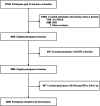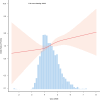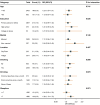The relationship between the triglyceride glucose-waist height ratio and benign prostatic hyperplasia in middle-aged and elderly adults: a nationwide cohort study
- PMID: 40611225
- PMCID: PMC12224367
- DOI: 10.1186/s12894-025-01844-1
The relationship between the triglyceride glucose-waist height ratio and benign prostatic hyperplasia in middle-aged and elderly adults: a nationwide cohort study
Abstract
Objective: Currently, evidence regarding the relationship between variations in the Triglyceride Glucose-Waist-to-Height Ratio (TyG-WHtR) and benign prostatic hyperplasia (BPH) remains scarce. This study aimed to examine the potential association between alterations in TyG-WHtR and the risk of developing BPH.
Methods: This study enrolled 3,296 male participants aged ≥ 45 years from the China Health and Retirement Longitudinal Study (CHARLS). Multivariable logistic regression analysis combined with restricted cubic spline models was employed to explore the potential relationship between TyG-WHtR variation and the risk of developing BPH.
Results: Over a 4-year follow-up period, 267 individuals were diagnosed with BPH. Elevated TyG-WHtR values were significantly associated with a higher risk of BPH (OR = 1.20, 95% CI: 1.02-1.43, p = 0.031), demonstrating a clear dose-response trend (p = 0.01). Furthermore, subgroup analyses revealed that this positive correlation between TyG-WHtR and BPH risk was consistently observed across multiple stratifications.
Conclusion: These findings highlight the potential metabolic links between TyG-WHtR and BPH, and underscore the need for future longitudinal studies to explore whether targeting these pathways may aid in BPH prevention.
Keywords: Benign prostatic hyperplasia; China Health and retirement longitudinal study; Cohort study; Linear response relationship; TyG-WHtR index.
© 2025. The Author(s).
Conflict of interest statement
Declarations. Ethics approval and consent to participate: This study was approved by the Biomedical Ethics Review Committee of Peking University (IRB00001052-11015). All participants provided written informed consent. Consent for publication: Not applicable. Competing interests: The authors declare no competing interests.
Figures



Similar articles
-
Association between modified triglyceride glucose indices and stroke risk in middle-aged and older Chinese adults: a prospective cohort study.Cardiovasc Diabetol. 2025 Jul 10;24(1):274. doi: 10.1186/s12933-025-02827-0. Cardiovasc Diabetol. 2025. PMID: 40640840 Free PMC article.
-
Association between the triglyceride-glucose-waist-to-height ratio and early arterial stiffness in cardiovascular-kidney-metabolic syndrome.Eur J Med Res. 2025 Jul 16;30(1):629. doi: 10.1186/s40001-025-02881-0. Eur J Med Res. 2025. PMID: 40665413 Free PMC article.
-
Comparative study of triglyceride glucose index and coronary heart disease risk in middle aged and elderly Chinese and British populations.Sci Rep. 2025 Jul 2;15(1):22637. doi: 10.1038/s41598-025-08133-9. Sci Rep. 2025. PMID: 40596403 Free PMC article.
-
Triglyceride-glucose-body mass index and the incidence of cardiovascular diseases: a meta-analysis of cohort studies.Cardiovasc Diabetol. 2025 Jan 22;24(1):34. doi: 10.1186/s12933-025-02584-0. Cardiovasc Diabetol. 2025. PMID: 39844258 Free PMC article. Review.
-
Relationship between the triglyceride-glucose index and risk of cardiovascular diseases and mortality in the general population: a systematic review and meta-analysis.Cardiovasc Diabetol. 2022 Jul 1;21(1):124. doi: 10.1186/s12933-022-01546-0. Cardiovasc Diabetol. 2022. PMID: 35778731 Free PMC article.
References
-
- Langan RC. Benign Prostatic Hyperplasia. Prim Care. 2019;46(2):223–32. - PubMed
-
- Infante Hernández S, Gómez Rivas J, Moreno Sierra J. Benign prostatic hyperplasia. Med Clin (Barc). 2024;163(8):407–14. - PubMed
-
- Devlin CM, Simms MS, Maitland NJ. Benign prostatic hyperplasia - what do we know? BJU Int. 2021;127(4):389–99. - PubMed
-
- Kaplan SA. Benign Prostatic Hyperplasia. J Urol. 2023;210(6):908–10. - PubMed
MeSH terms
Substances
LinkOut - more resources
Full Text Sources
Medical

